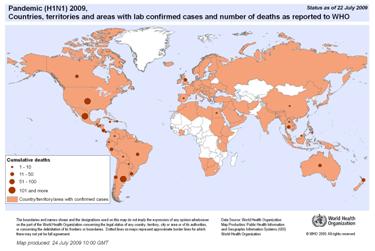Unsafe At Any Speed, Anywhere
Human H1N1 influenza cases have been confirmed in almost every part of the Earth inhabited by people, WHO confirmed last week. And Virginia Tech Transportation Institute researchers, via The New York Times, released what should be the definitive study of cell phone use by drivers. You already know what they found: The risk of a crash or near crash was 23 times higher for long-haul truck drivers who texted while driving then for comparable truckers who were not texting as they drove.
 It's not safe to go anywhere, is it? The World Health Organization's H1N1 map paints every country I've visited, and many more, in orange to indicate confirmed cases have been found there. Whatever desire I had to live in Greenland or central Africa, which aren't colored orange, vanished when I read the July 27 advisory from WHO. It listed the countries and overseas territories/communities that reported their H1N1 confirmed case(s) between July 6 and July 22: Afghanistan, Andorra, Belize, Bhutan, Botswana, La Réunion (French Overseas Community) , Haiti, the Marshall Islands, the Federated States of Micronesia, Namibia, Sint Eustatius (Netherlands Antilles), Saint Kitts and Nevis, Saint Vincent and the Grenadines, Seychelles, Solomon Islands, the Sudan, Tonga, Turks and Caicos Islands (UK Overseas Territory), the United Republic of Tanzania, American Samoa, Guam. Even tiny island outposts of the Pacific have flu cases, in other words. The advisory indicated 134,503 confirmed cases and 816 deaths had been confirmed worldwide as of July 22. "Given that countries are no longer required to test and report individual cases, the number of cases reported actually understates the real number of cases," it said.
It's not safe to go anywhere, is it? The World Health Organization's H1N1 map paints every country I've visited, and many more, in orange to indicate confirmed cases have been found there. Whatever desire I had to live in Greenland or central Africa, which aren't colored orange, vanished when I read the July 27 advisory from WHO. It listed the countries and overseas territories/communities that reported their H1N1 confirmed case(s) between July 6 and July 22: Afghanistan, Andorra, Belize, Bhutan, Botswana, La Réunion (French Overseas Community) , Haiti, the Marshall Islands, the Federated States of Micronesia, Namibia, Sint Eustatius (Netherlands Antilles), Saint Kitts and Nevis, Saint Vincent and the Grenadines, Seychelles, Solomon Islands, the Sudan, Tonga, Turks and Caicos Islands (UK Overseas Territory), the United Republic of Tanzania, American Samoa, Guam. Even tiny island outposts of the Pacific have flu cases, in other words. The advisory indicated 134,503 confirmed cases and 816 deaths had been confirmed worldwide as of July 22. "Given that countries are no longer required to test and report individual cases, the number of cases reported actually understates the real number of cases," it said.
Researchers conducted the texting study by placing video cameras inside the cabs of long-haul truckers for 18 months to observe their behavior -- specifically, how long they watched the screen, instead of the road on which they were traveling, when sending or receiving a text.
Fourteen states have banned texting by some or all drivers. The Times article, posted July 27, also cited a University of Utah study of college students using a driving simulator. This second study concluded their risk of crashing while texting and driving was eight times higher than while driving without texting, according to the newspaper.
Late last month, safety blogs including The Pump Handle were talking about a Times article that alleged top officials of the National Highway Traffic Safety Administration withheld research data showing calling while driving was a serious safety risk and refused in 2003 to authorize a broader study of this subject. The agency "Failed to Issue Warnings on Phoning While Driving," according to The Pump Handle's headline.
If this was a coverup, who was misled? While I can't recall the first time I read a warning that using a cell phone while driving was unwise, I've always known it was. Haven't you? Texting while driving obviously takes much more concentration, thus robbing the driver's attention from the road and other drivers all the more.
I witness all kinds of unsafe driving as I commute to and from Dallas, Texas. Speeding and tailgating are the big ones. Sometimes, but not often, I can see a cell phone being used. I'm wary of everyone else on the road, and a ban on calling or texting won't change that in the least.
Posted by Jerry Laws on Aug 03, 2009